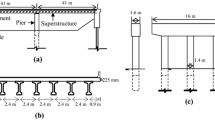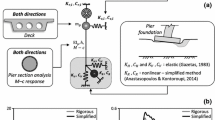Abstract
The dynamic response and seismic performance of bridges may be appreciably affected by numerous contributing factors, with soil–structure interaction being the dominant exogenous influence. The most familiar form is the so-called soil–pile interaction, but embankment–abutment interaction is also documented through field observations and analytical investigations, particularly evident in integral R.C. bridges. Recent studies have shown that this form of interaction may significantly alter the bridge response and should be taken into account during design and assessment, especially in the case of typical highway overcrossings that have abutments supported on earth embankments. In light of this emerging problem and in order to facilitate quantitative estimates of the interaction effects, the question of appropriate modeling and seismic assessment of R.C. integral bridges is the main object of the present paper. Based on already established procedures to account for soil–structure interaction, a new approach is proposed to model the contribution of the embankment, the bent and the abutments to the overall bridge response. Furthermore, the capacity curve of the entire bridge system is evaluated through the implementation of Incremental Dynamic Analysis (IDA), therefore allowing for seismic assessment of the complex superstructure–foundation system with well established displacement based procedures. Using as a benchmark case two typical instrumented U.S. highway bridges located in California, the proposed method is implemented and provided results from this analysis are correlated successfully with available field data. Results obtained from the analysis indicate excessive displacement demands for the entire bridge–embankment system owing to the embankment contribution and the soil degradation under increasing shear strains. Furthermore, seismic performance is strongly related to the central bent deformation capacity, with soil–pile interaction effects being of critical importance.
Similar content being viewed by others
Abbreviations
- u(x, y):
-
Embankment displacements as a function of x and y coordinates
- ρ, G(z):
-
Soil density and Soil shear modulus as a function of depth z
- B c , L c :
-
Effective Embankment Crest Width, Embankment Critical Length
- H, L :
-
Embankment Height, Embankment Length
- f s , D :
-
Pile skin resistance, Pile diameter
- x, y, z :
-
Transverse, Longitudinal and Vertical axes (Embankment model)
- \({\Phi ({y,z})}\) :
-
Deformation shape as a function of y and z coordinates (Embankment model)
- \({M_{\rm tot}^\ast , K_{\rm tot}^\ast , C_{\rm tot}^\ast}\) :
-
Generalized mass, Stiffness and Damping Coefficient (for the generalized SDOF representation of the Embankment)
- \({\Im_{\rm tot}^\ast , \xi}\) :
-
Generalized system excitation factor, damping ratio of the consistently-linearized Embankment model
- Y(t):
-
A time dependent generalized coordinate (Embankment model)
- u g :
-
Imposed ground displacements
- M center, M edge :
-
Deck mass (center), Deck mass (edge) (Deck–pier–abutment substructure model)
- M emb, C emb :
-
Embankment lumped mass attached on the deck, lumped damper property attached on the deck to represent the embankment contribution (Deck–pier–abutment substructure model)
- K deck, K bent, K abut K emb :
-
Deck stiffness, Bent stiffness, Abutment stiffness and Embankment stiffness contributions to the deck–pier–abutment substructure model.
- u tot, u 1, α 1 :
-
Total transverse displacements, Bent relative transverse displacements, Bent–abutment displacement ratio
- u y , u D , μ d :
-
Apparent Yield Displacement, Displacement Demand, Displacement ductility (bridge–embankment system)
- \({p_l ,p_{s,\rm vol}^h , P/{A_g f_c}}\) :
-
Longitudinal reinforcement ratio, transverse volumetric steel ratio of the column cross-section, axial load ratio.
References
AASHTO-83 (1988) Guide specifications for seismic design of highway bridges. American Association of State Highway and Transportation Officials, Washington
Aschheim M, Black E (2000) Yield point spectra for seismic design and rehabilitation. Earthq Spectra Earthq Eng Res Inst 16(2): 317–335
Bowles J (1996) Foundation analysis and design. 5th edn. McGraw-Hill
CALTRANS (2006) CALTRANS seismic design criteria, version 1.4. California Department of Transportation, Sacramento, USA
Elwood K, Moehle J (2004) Evaluation of existing reinforced concrete columns, Proceedings, 13th World Conference on Earthquake Engineering, Vancouver
Fajfar P (1999) Capacity spectrum method based on inelastic demand spectra. Earthq Eng Struct Dyn 28(9): 979–993
Fajfar P (2000) A nonlinear analysis method for performance-based seismic design. EERI Earthq Spectra 16(3): 573–592
FEMA-274 (1997) NEHRP commentary on the guidelines for the seismic rehabilitation of buildings, report No. FEMA-274, Federal Emergency Management Agency, Washington, D.C., October 1997
Gazetas G (1987) Seismic response of earth dams: some recent developments. Soil Dyn Earthq Eng 6(1): 3–47
Goel RK, Chopra AK (1997) Evaluation of bridge abutment capacity and stiffness during earthquakes. Earthq Spectra 13(1): 1–23
Heuze FE, Swift RP (1991) Seismic refraction studies at the Painter Street Bridge site, Rio Dell, California. Report UCRL-ID-108595. Lawrence Livermore National Laboratory, Oak Ridge, TN
Inel M (2001) Displacement-based strategies for the performance-based seismic design of “short” bridges considering embankment flexibility. Thesis, University of Illinois at Urbana-Champaign
Inel M, Aschheim MA (2004) Seismic design of columns of short bridges accounting for embankment flexibility. J Struct Eng 130(10): 1515–1528
Iwasaki T, Tatsuoka F, Takagi Y (1978) Shear moduli of sands under cyclic torsional shear loading. Soils Found 18(1): 39–56
Kappos A, Potikas P, Sextos A (2007) Seismic assessment of an overpass bridge accounting for non- linear material and soil response and varying boundary conditions, Computational methods in structural dynamics and earthquake engineering, COMPDYN 2007, Rethymnon, Greece
Kotsoglou A, Pantazopoulou S (2007a) Bridge–embankment interaction under transverse ground excitation. Earthq Eng Struct Dyn 36(12): 1719–1740
Kotsoglou A, Pantazopoulou S (2007b) Soil–structure interaction: capacity curve evaluation and seismic assessment of highway overcrossings, 4th ICEGE-international conference on earthquake geotechnical engineering, Thessaloniki, Greece, 25–28 June 2007
Mackie K, Stojadinovic B (2003) Seismic demands for performance-based design of bridges. PEER Report 2003/16. Pacific Earthquake Engineering Research Center, University of California, Berkeley, CA
McCallen DB, Romstad KM (1994) Dynamic analysis of a skewed short-span, box-girder overpass. Earthq Spectra 10(4): 729–755
Mori A, Crouse C (1981) Strong motion data from Japanese earthquakes, World Data Center for Solid Earth Geophysics, Report SE-29
Mylonakis G, Nikolaou A, Gazetas G (1997) Soil–pile–bridge seismic interaction: kinematic and inertial effects, part I: soft soil. Earthq Eng Struct Dyn 26(3): 337–360
Newmark NM, Hall WJ (1973) Seismic design criteria for nuclear reactor facilities, building practices for disaster mitigation, Report Number 46, National Bureau of Standards, U.S. Department of Commerce, 209–236
Panagiotakos TB, Fardis MN (2001) Deformation of reinforced concrete members at yielding and ultimate. ACI Struct J 98(2): 135–148
Papazachos B (1996) Large seismic faults in the Hellenic arc. Annali di Geofisica 39: 891–903
Price TE, Eberhard MO (1998) Effects of spatially varying ground motions on short bridges. J Struct Eng 124(8): 948–955
Priestley MJN, Seible F, Calvi GM (1996) Seismic design and retrofit of bridges. Wiley, New York
Seed HB, Idriss IM (1970) Soil moduli and damping factors for dynamic response analysis. Report Number EERC70-10, University of California, Berkeley, CA
Tatsuoka F, Iwasaki T, Takagi Y (1978) Hysteretic damping of sands under cyclic loading and its relation to shear modulus. Soils Found 18(2): 25–40
Theodulidis N (2002) Strong motion simulation of large intermediate depth earthquakes in SE Europe, Proceedings of the 12th ECEE, paper Mo. 668 (on CD)
Tomlinson MJ (1971) Some effects of pile driving on skin friction. Proceedings, conference on behavior of piles, ICE, London, pp 107–114
Vamvatsikos D, Cornell CA (2004) Applying incremental dynamic analysis. Earthq Spectra 20(2): 523–553
Vucetic M, Dobry R (1991) Effect of soil plasticity on cyclic response. J Geotech Eng, ASCE 117(1): 89–107
Wilson JC, Tan BS (1990a) Bridge abutments: formulation of a simple model for earthquake response analysis. J Eng Mech 116(8): 1828–1837
Wilson JC, Tan BS (1990b) Bridge abutments: assessing their influence on earthquake response of meloland road overpass. J Eng Mech 116(8): 1838–1856
Wissawapaisal C (1999) Modelling the seismic response of short bridges. PhD Thesis, University of Illinois at Urbana-Champaign
Zhang J, Makris N (2001) Seismic response of highway overcrossings including soil–structure interaction. Report No: UCB/PEER 2001/02, University of California, Berkeley, February 2001
Zhang J, Makris N (2002a) Kinematic response functions and dynamic stiffnesses of bridge embankments. Earthq Eng Struct Dyn 31: 1933–1966
Zhang J, Makris N (2002b) Seismic response analysis of highway overcrossings including soil–structure interaction. Earthq Eng Struct Dyn 31: 1967–1991
Author information
Authors and Affiliations
Corresponding author
Rights and permissions
About this article
Cite this article
Kotsoglou, A.N., Pantazopoulou, S.J. Assessment and modeling of embankment participation in the seismic response of integral abutment bridges. Bull Earthquake Eng 7, 343–361 (2009). https://doi.org/10.1007/s10518-009-9103-z
Received:
Accepted:
Published:
Issue Date:
DOI: https://doi.org/10.1007/s10518-009-9103-z




